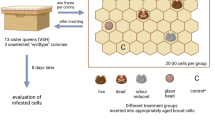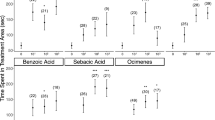Abstract
Varroa destructor, an acarian parasite of the Western honey bee Apis mellifera L., is a serious threat to colonies and beekeeping worldwide. The parasite lifecycle occurs in close synchrony with its host development. The females have to discriminate between different developmental stages of the host and trigger an appropriate behavioral response. Many studies have focused on these behavioral aspects, whether it is the choice of a precise host stage or the reproduction of female mites. Behavioral tests often require laboratory settings that are very different from the mite’s environment. Our first experiment was designed to study the impact of the surface of test arena on the mite behavior. We found that plastic from Petri dishes commonly used as test arenas disturbs the female mites and can cause death. We searched for a substrate that does not harm mites and found that gelatin-coated plastic Petri dishes responded to these expectations. We then investigated the host choice behavior of phoretic mites confronted with larval stages of the bee on gelatin-coated arenas to watch if the well-documented orientation towards 5th instar larva was observable in our conditions. Pupal stages were included in the host choice experiments, initially to act as neutral stimuli. As white-eyed pupae were revealed attractive to the mite, several pupal stages were then included in a series of host choice bioassays. These additional experiments tend to show that the positive response to the white-eyed pupa stage depends on cues only delivered by living pupae. Further investigation on the nature and impact of these cues are needed as they could shed light on key signals involved in the parasite lifecycle.



Similar content being viewed by others
Data availability
The datasets generated during and/or analyzed during the current study are available from the corresponding author on reasonable request.
References
Aumeier P, Rosenkranz P, Francke W (2002) Cuticular volatiles, attractivity of worker larvae and invasion of brood cells by Varroa mites. A comparison of Africanized and European honey bees. Chemoecology 12(2):65–75
Ayasse M, Schiestl FP, Paulus HF, Ibarra F, Francke W (2003) Pollinator attraction in a sexually deceptive orchid by means of unconventional chemicals. Proc R Soc Lond B 270(1514):517–522
Beetsma J (1994) The Varroa mite, a devastating parasite of Western honeybees and economic threat to beekeeping. Outlook Agric 23(3):169–175
Boot WJ, Calis JNM, Beetsma J (1992) Differential periods of Varroa mite invasion into worker and drone cells of honey bees. Exp Appl Acarol 16:295–301
Boot WJ, Sisselaar DJA, Calis JNM (1994) Behaviour of Varroa mites invading honey bee brood cells. Exp Appl Acarol 18(6):371–379
Boulay R, Hefetz A, Soroker V, Lenoir A (2000) Camponotus fellah colony integration: worker individuality necessitates frequent hydrocarbon exchanges. Anim Behav 59(6):1127–1133
Calderone NW, Lin S (2001) Behavioural responses of Varroa destructor (Acari: Varroidae) to extracts of larvae, cocoon and brood food of worker and drone honey bee, Apis mellifera (Hymenoptera: Apidae). Physiol Entomol 26:341–350
Colin ME, Richard D, Fourcassie V, Belzunces LP (1992) Attraction of Varroa jacobsoni, parasite of Apis mellifera by electrical charges. J Insect Physiol 38(2):111–117
Del Piccolo F, Nazzi F, Vedova GD, Milani N (2010) Selection of Apis mellifera workers by the parasitic mite Varroa destructor using host cuticular hydrocarbons. Parasitology 137:967–973
Dietemann V, Nazzi F, Martin SJ, Anderson DL, Locke B, Delaplane KS, Wauquiez Q, Tannahill C, Frey E, Ziegelmann B, Rosenkranz P, Ellis JD (2013) Standard methods for varroa research. J Apic Res 52(1):1–54
Donzé G, Guerin PM (1994) Behavioral attributes and parental care of Varroa mites parasitizing honeybee brood. Behav Ecol Sociobiol 34:305–319
Donzé G, Herrmann M, Bachofen B, Guerin PM (1996) Effect of mating frequency and brood cell infestation rate on the reproduction success of the honeybee parasite Varroa jacobsoni. Ecol Entomol 21(1):17–26
Donzé G, Schnyder-Candrian S, Bogdanov S, Diehl PA, Guerin PM, Kilchenman V, Monachon F (1998) Aliphatic alcohols and aldehydes of the honey bee cocoon induce arestment behavior in Varroa jacobsoni (Acari: Mesostigmata), an ectoparasite of Apis mellifera. Arch Insect Biochem Physiol 37(2):129–145
Egekwu EI, Posada F, Sonenshine DE, Cook S (2018) Using an in vitro system for maintaining Varroa destructor mites on Apis mellifera pupae as hosts: studies of mite longevity and feeding behavior. Exp Appl Acarol 74(3):301–315
Frey E, Odemer R, Blum T, Rosenkranz P (2013) Activation and interruption of the reproduction of Varroa destructor is triggered by host signals (Apis mellifera). J Invertebr Pathol 113(1):56–62
Gallai N, Salles JM, Settele J, Vaissière BE (2009) Economic valuation of the vulnerability of world agriculture confronted with pollinator decline. Ecol Econ 68(3):810–821
Giuffre C, Lubkin SR, Tarpy D (2019) Does viral loads alter behaviour of the bee parasite Varroa destructor? PLoS One 14(6):e0217975
Ifantidis MD (1983) Ontogenesis of the mite Varroa jacobsoni in worker and drone honeybee brood cells. J Apic Res 22(3):200–206
Ifantidis MD (1988) Some aspects of the process of Varroa jacobsoni mite entrance into honey bee (Apis mellifera) brood cell. Apidologie 19(4):387–396
Kirchner WH (1993) Visual and vibrational sensitivity in Varroa. Apidologie 24(5):490–492
Kraus B (1990) Effects of honey-bee alarm pheromone compounds on the behaviour of Varroa jacobsoni. Apidologie 21(2):127–134
Kraus B (1994) Factors influencing host choice of the honey bee parasite Varroa jacobsoni oud. Exp Appl Acarol 18(7):435–443
Le Conte Y, Arnold G (1987) Influence de l’âge des abeilles (Apis mellifica L.) et de la chaleur sur le comportement de Varroa jacobsoni Oud. Apidologie 18(4):305–320
Le Conte Y Arnold G (1988) Implied sensory signals in the honeybee-Varroa relationship. In: Cavalloro R (ed) European research on Varroatosis control, pp 41-49
Le Conte Y, Arnold G, Trouiller J, Masson C, Chappe B, Ourisson G (1989) Attraction of the parasitic mite Varrroa to the drone larvae of honey bees by simple aliphatic esters. Science 245(4918):638–639
LeDoux MN, Pernal SF, Higo HA, Winston ML (2000) Development of a bioassay to test the orientation behaviour of the honey bee ectoparasite, Varroa jacobsoni. J Apic Res 39(1-2):47–54
Losey JE, Vaughan M (2006) The economic value of ecological services provided by insects. Bioscience 56:311–323
Maggi M, Damiani N, Ruffinengo S, De Jong D, Principal J, Eguaras M (2010) Brood cell size of Apis mellifera modifies the reproductive behaviour of Varroa destructor. Exp Appl Acarol 50(3):269–279
Nazzi F, Le Conte Y (2015) Ecology of Varroa destructor, the major ectoparasite of the Western honey bee, Apis mellifera. Annu Rev Entomol 61:417–432
Nazzi F, Milani N (1994) A technique for reproduction of Varroa jacobsoni oud under laboratory conditions. Apidologie 25(6):579–584
Nazzi F, Milani N, Della Vedova G, Nimis M (2001) Semiochemicals from larval food affect the locomotory behaviour of Varroa destructor. Apidologie 32(2):149–155
Nazzi F, Milani N, Della Vedova G (2004) A semiochemical from larval food influences the entrance of Varroa destructor into brood cells. Apidologie 35(4):403–410
Neu CW, Byers CR, Peek JM (1974) A technique for analysis of utilization-availability data. J Wildl Manag 38(3):541–545
Pernal SF, Baird DS, Birmingham AL, Higo HA, Slessor KN, Winston ML (2005) Semiochemicals influencing the host-finding behaviour of Varroa destructor. Exp Appl Acarol 37(1):1–26
Perret JL, Guerin PM, Diehl PA, Vlimant M, Gern L (2003) Darkness induces mobility, and saturation deficit limits questing duration, in the tick Ixodes ricinus. J Exp Biol 206:1809–1815
Piou V, Tabart J, Urrutia V, Hemptinne JL, Vétillard A (2016) Impact of the phoretic phase on reproduction and damage caused by Varroa destructor (Anderson and Trueman) to its host, the European honey bee (Apis mellifera L.). PLoS ONE 11(4):e0153482
Piou V, Tabart J, Hemptinne JL, Vétillard A (2018) Effect of pollen supplementation on the varroatosis tolerance of honey bee (Apis mellifera L.) larvae reared in vitro. Exp Appl Acarol 74(1):25–41
Rembold H, Kremer JP, Ulrich GM (1980) Characterization of posembryonic developmental stages of the female castes of the honey bee, Apis mellifera L. Apidologie 11(1):29–38
Rickli M, Guerin PM, Diehl PA (1992) Palmitic acid release from honeybee worker larvae attracts the parasitic mite Varroa jacobsoni on a servosphere. Naturwissenschaften 79(7):320–322
Rickli M, Diehl PA, Guerin PM (1994) Cuticle alkanes of honeybee larvae mediate arrestment of bee parasite Varroa jacobsoni. J Chem Ecol 20(9):2437–2453
Rosenkranz P (1993) A bioassay for the investigation of host-finding behaviour in Varroa jacobsoni. Apidologie 24(5):159–172
Rosenkranz P, Aumeier P, Ziegelmann B (2010) Biology and control of Varroa destructor. J Invertebr Pathol 103:S96–S119
Smith KM, Loh EH, Rostal MK, Zambrana-Torrelio CM, Mendiola L, Daszak P (2013) Pathogens, pests, and economics: drivers of honey bee colony declines and losses. EcoHealth 10(4):434–445
Trouiller J, Milani N (1999) Stimulation of Varroa jacobsoni Oud. oviposition with semiochemicals from honeybee brood. Apidologie 30:3–12
Trouiller J, Arnold G, Le Conte Y, Masson C (1991) Temporal pheromonal and kairomonal secretion in the brood of honeybees. Naturwissenschaften 78:368–370
Trouiller J, Arnold G, Chappe B, Le Conte Y, Masson C (1992) Semiochemical basis of infestation of honey bee brood by Varroa jacobsoni. J Chem Ecol 18(11):2041–2053
Wilson JG, Kinzer DR, Sauer JR, Hair JA (1972) Chemo-attraction in the lone star tick (Acarina: Ixodidae): I. Response of different developmental stages to carbon dioxide administered via traps. J Med Entomol 9(3):245–252
Zetlmeisl K, Rosenkranz P (1994) Varroa-Weibchen im Biotest: Wirtserkennung von Bienenlarven und adulten Bienen. Apidologie 25(5):507–508
Acknowledgments
We would like to thank Tessa Smith from the University of Tasmania for English proofreading.
Funding
This study was funded by Région Midi-Pyrénées and Institut National Universitaire Jean-François Champollion (Grant no. 12050616). JLH was supported by the French Laboratory of Excellence projects TULIP (Towards a Unified theory of biotic Interactions: the role of environmental Perturbations; ANR-10-LABX-41, ANR-11-IDEX-0002-02) and CEBA (Centre d’Etude de la Biodiversité Amazonienne; ANR-10-LABX-25-01).
Author information
Authors and Affiliations
Corresponding author
Ethics declarations
All applicable international, national, and institutional guidelines currently in force for the care and use of animals were followed.
Conflict of interest
The authors declare that they have no competing interests.
Additional information
Section Editor: Helge Kampen
Publisher’s note
Springer Nature remains neutral with regard to jurisdictional claims in published maps and institutional affiliations.
Electronic supplementary material
ESM 1
(DOCX 30 kb)
Rights and permissions
About this article
Cite this article
Piou, V., Urrutia, V., Laffont, C. et al. The nature of the arena surface affects the outcome of host-finding behavior bioassays in Varroa destructor (Anderson & Trueman). Parasitol Res 118, 2935–2943 (2019). https://doi.org/10.1007/s00436-019-06435-2
Received:
Accepted:
Published:
Issue Date:
DOI: https://doi.org/10.1007/s00436-019-06435-2




